ACCT6006 Auditing Assignment: Dick Smith's Collapse and Audit Failures
VerifiedAdded on 2022/10/18
|15
|3518
|362
Report
AI Summary
This report provides a comprehensive analysis of the collapse of Dick Smith Electronics, focusing on the auditing aspects that contributed to its downfall. The report begins with a brief history of the company and then delves into the key reasons for its collapse, including financial mismanagement, rapid expansion, and inventory issues. It examines the alleged breaches of Australian Accounting Standards (AAS) by the auditors, specifically regarding revenue recognition and rebates. The report also identifies the going concern issues present in Dick Smith's financial statements, such as declining cash flow, excessive borrowing, and rising costs. Furthermore, it analyzes the reasons behind the issuance of an unmodified audit report by Deloitte Touche Tohmatsu, evaluating the auditor's responsibilities and the basis for their opinion. The report concludes by summarizing the key findings and highlighting the importance of robust auditing practices in preventing corporate failures.
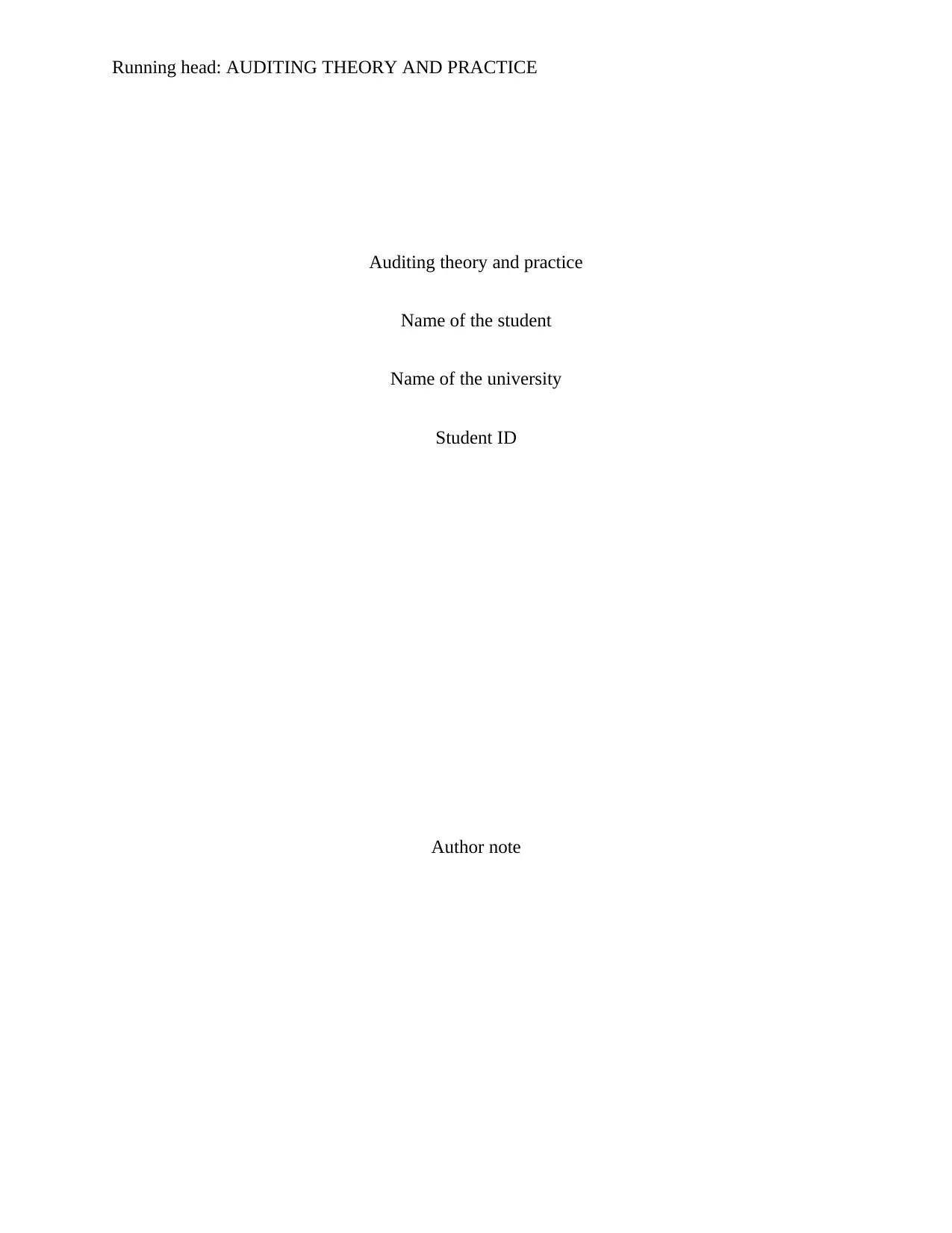
Running head: AUDITING THEORY AND PRACTICE
Auditing theory and practice
Name of the student
Name of the university
Student ID
Author note
Auditing theory and practice
Name of the student
Name of the university
Student ID
Author note
Paraphrase This Document
Need a fresh take? Get an instant paraphrase of this document with our AI Paraphraser
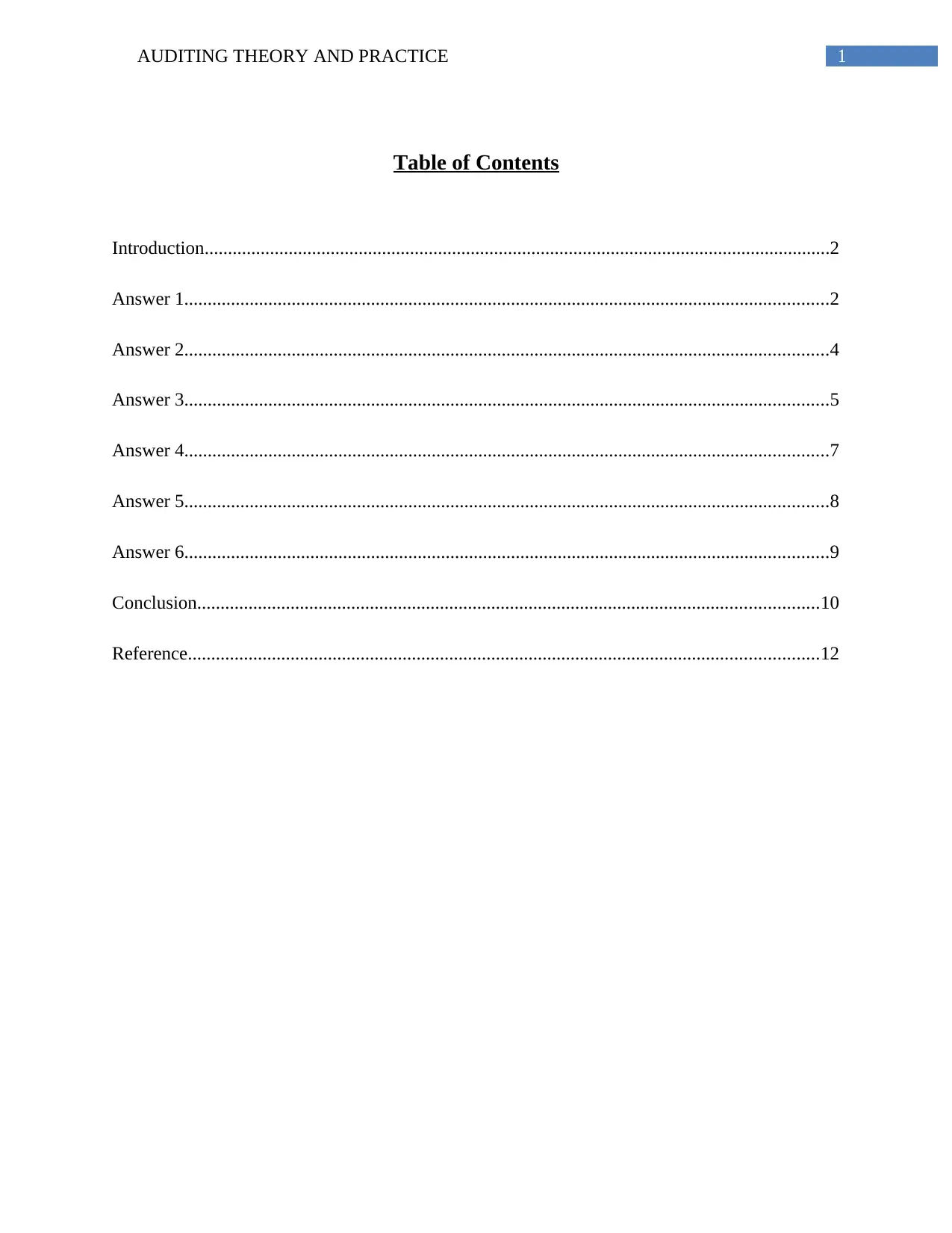
1AUDITING THEORY AND PRACTICE
Table of Contents
Introduction......................................................................................................................................2
Answer 1..........................................................................................................................................2
Answer 2..........................................................................................................................................4
Answer 3..........................................................................................................................................5
Answer 4..........................................................................................................................................7
Answer 5..........................................................................................................................................8
Answer 6..........................................................................................................................................9
Conclusion.....................................................................................................................................10
Reference.......................................................................................................................................12
Table of Contents
Introduction......................................................................................................................................2
Answer 1..........................................................................................................................................2
Answer 2..........................................................................................................................................4
Answer 3..........................................................................................................................................5
Answer 4..........................................................................................................................................7
Answer 5..........................................................................................................................................8
Answer 6..........................................................................................................................................9
Conclusion.....................................................................................................................................10
Reference.......................................................................................................................................12
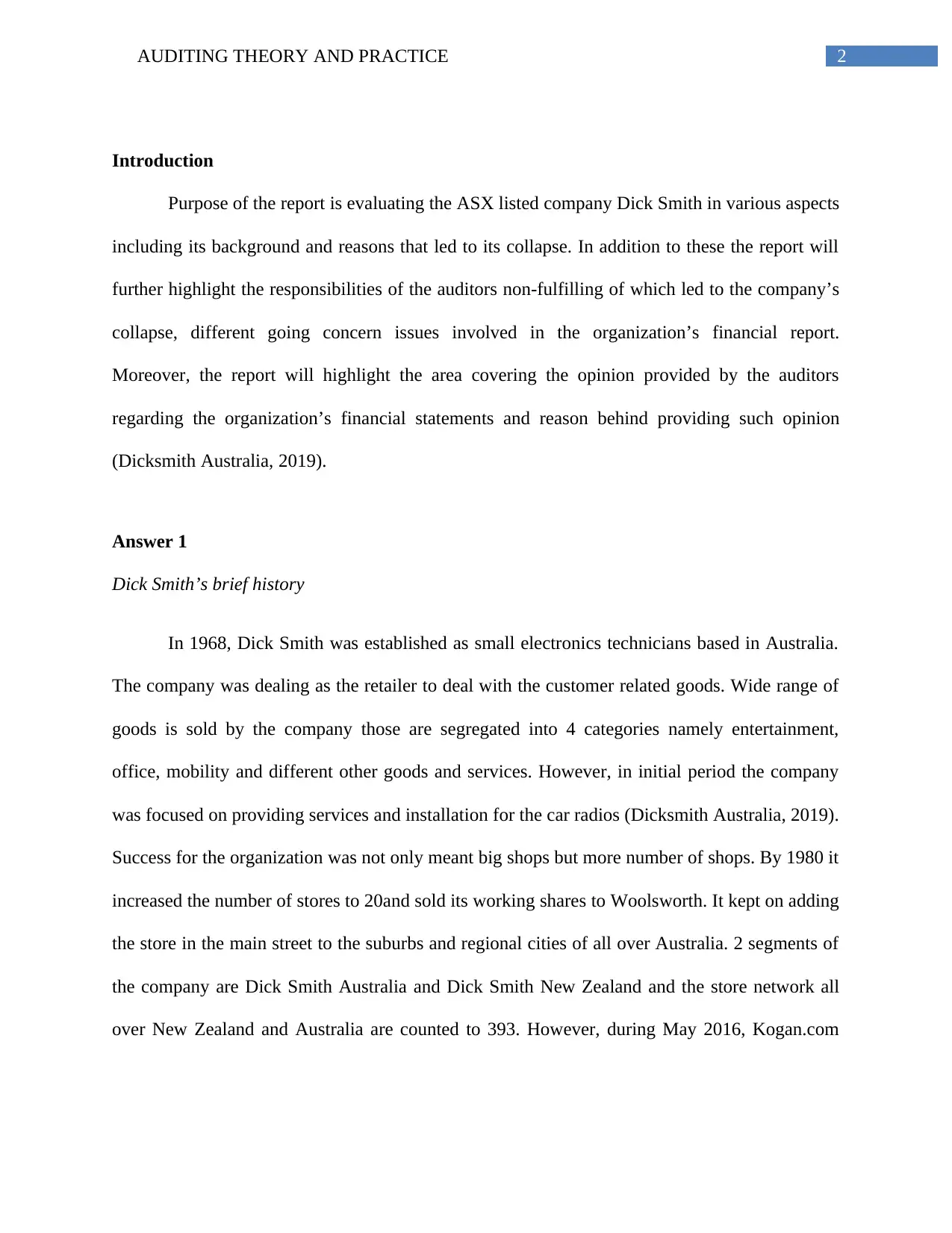
2AUDITING THEORY AND PRACTICE
Introduction
Purpose of the report is evaluating the ASX listed company Dick Smith in various aspects
including its background and reasons that led to its collapse. In addition to these the report will
further highlight the responsibilities of the auditors non-fulfilling of which led to the company’s
collapse, different going concern issues involved in the organization’s financial report.
Moreover, the report will highlight the area covering the opinion provided by the auditors
regarding the organization’s financial statements and reason behind providing such opinion
(Dicksmith Australia, 2019).
Answer 1
Dick Smith’s brief history
In 1968, Dick Smith was established as small electronics technicians based in Australia.
The company was dealing as the retailer to deal with the customer related goods. Wide range of
goods is sold by the company those are segregated into 4 categories namely entertainment,
office, mobility and different other goods and services. However, in initial period the company
was focused on providing services and installation for the car radios (Dicksmith Australia, 2019).
Success for the organization was not only meant big shops but more number of shops. By 1980 it
increased the number of stores to 20and sold its working shares to Woolsworth. It kept on adding
the store in the main street to the suburbs and regional cities of all over Australia. 2 segments of
the company are Dick Smith Australia and Dick Smith New Zealand and the store network all
over New Zealand and Australia are counted to 393. However, during May 2016, Kogan.com
Introduction
Purpose of the report is evaluating the ASX listed company Dick Smith in various aspects
including its background and reasons that led to its collapse. In addition to these the report will
further highlight the responsibilities of the auditors non-fulfilling of which led to the company’s
collapse, different going concern issues involved in the organization’s financial report.
Moreover, the report will highlight the area covering the opinion provided by the auditors
regarding the organization’s financial statements and reason behind providing such opinion
(Dicksmith Australia, 2019).
Answer 1
Dick Smith’s brief history
In 1968, Dick Smith was established as small electronics technicians based in Australia.
The company was dealing as the retailer to deal with the customer related goods. Wide range of
goods is sold by the company those are segregated into 4 categories namely entertainment,
office, mobility and different other goods and services. However, in initial period the company
was focused on providing services and installation for the car radios (Dicksmith Australia, 2019).
Success for the organization was not only meant big shops but more number of shops. By 1980 it
increased the number of stores to 20and sold its working shares to Woolsworth. It kept on adding
the store in the main street to the suburbs and regional cities of all over Australia. 2 segments of
the company are Dick Smith Australia and Dick Smith New Zealand and the store network all
over New Zealand and Australia are counted to 393. However, during May 2016, Kogan.com
⊘ This is a preview!⊘
Do you want full access?
Subscribe today to unlock all pages.

Trusted by 1+ million students worldwide
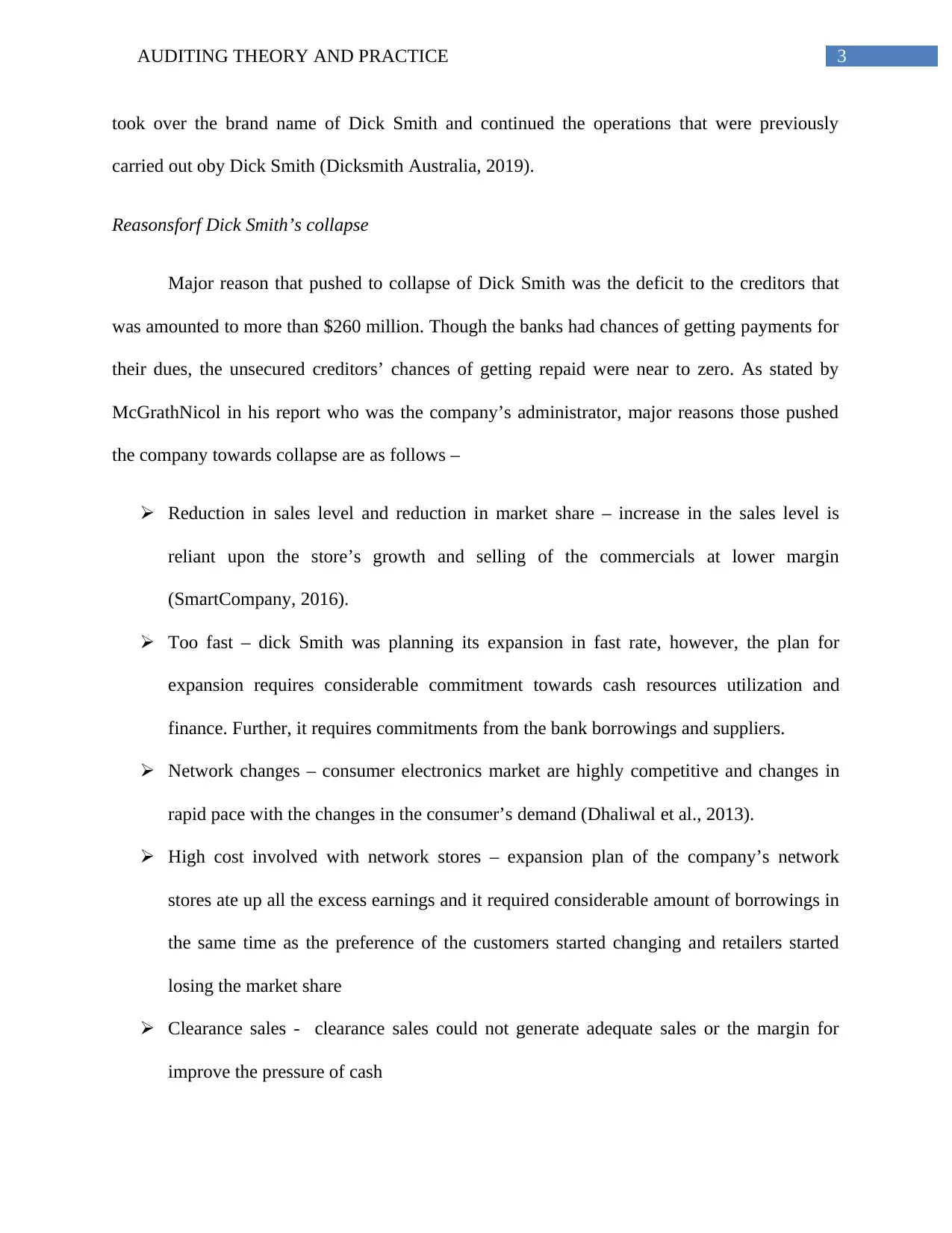
3AUDITING THEORY AND PRACTICE
took over the brand name of Dick Smith and continued the operations that were previously
carried out oby Dick Smith (Dicksmith Australia, 2019).
Reasonsforf Dick Smith’s collapse
Major reason that pushed to collapse of Dick Smith was the deficit to the creditors that
was amounted to more than $260 million. Though the banks had chances of getting payments for
their dues, the unsecured creditors’ chances of getting repaid were near to zero. As stated by
McGrathNicol in his report who was the company’s administrator, major reasons those pushed
the company towards collapse are as follows –
Reduction in sales level and reduction in market share – increase in the sales level is
reliant upon the store’s growth and selling of the commercials at lower margin
(SmartCompany, 2016).
Too fast – dick Smith was planning its expansion in fast rate, however, the plan for
expansion requires considerable commitment towards cash resources utilization and
finance. Further, it requires commitments from the bank borrowings and suppliers.
Network changes – consumer electronics market are highly competitive and changes in
rapid pace with the changes in the consumer’s demand (Dhaliwal et al., 2013).
High cost involved with network stores – expansion plan of the company’s network
stores ate up all the excess earnings and it required considerable amount of borrowings in
the same time as the preference of the customers started changing and retailers started
losing the market share
Clearance sales - clearance sales could not generate adequate sales or the margin for
improve the pressure of cash
took over the brand name of Dick Smith and continued the operations that were previously
carried out oby Dick Smith (Dicksmith Australia, 2019).
Reasonsforf Dick Smith’s collapse
Major reason that pushed to collapse of Dick Smith was the deficit to the creditors that
was amounted to more than $260 million. Though the banks had chances of getting payments for
their dues, the unsecured creditors’ chances of getting repaid were near to zero. As stated by
McGrathNicol in his report who was the company’s administrator, major reasons those pushed
the company towards collapse are as follows –
Reduction in sales level and reduction in market share – increase in the sales level is
reliant upon the store’s growth and selling of the commercials at lower margin
(SmartCompany, 2016).
Too fast – dick Smith was planning its expansion in fast rate, however, the plan for
expansion requires considerable commitment towards cash resources utilization and
finance. Further, it requires commitments from the bank borrowings and suppliers.
Network changes – consumer electronics market are highly competitive and changes in
rapid pace with the changes in the consumer’s demand (Dhaliwal et al., 2013).
High cost involved with network stores – expansion plan of the company’s network
stores ate up all the excess earnings and it required considerable amount of borrowings in
the same time as the preference of the customers started changing and retailers started
losing the market share
Clearance sales - clearance sales could not generate adequate sales or the margin for
improve the pressure of cash
Paraphrase This Document
Need a fresh take? Get an instant paraphrase of this document with our AI Paraphraser
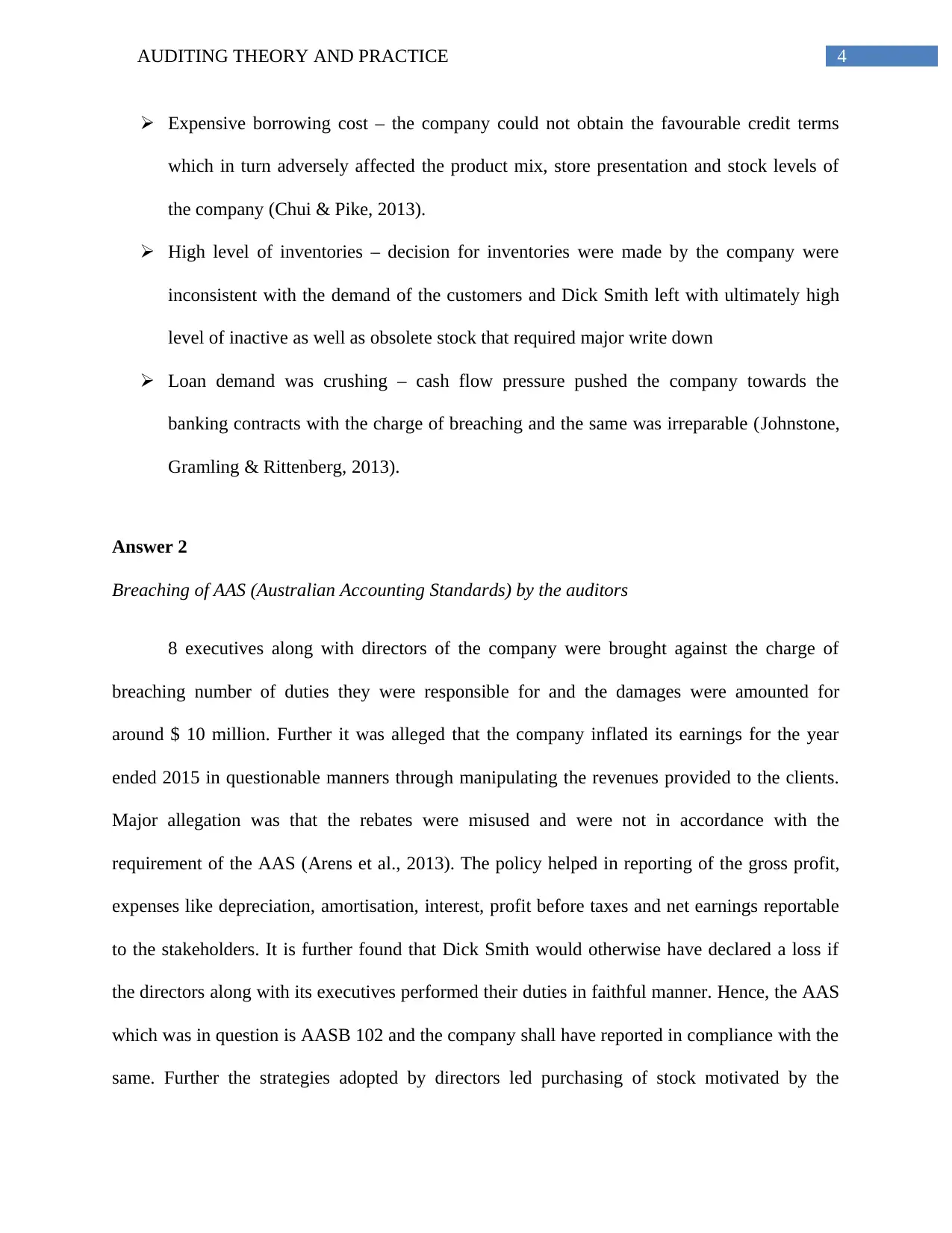
4AUDITING THEORY AND PRACTICE
Expensive borrowing cost – the company could not obtain the favourable credit terms
which in turn adversely affected the product mix, store presentation and stock levels of
the company (Chui & Pike, 2013).
High level of inventories – decision for inventories were made by the company were
inconsistent with the demand of the customers and Dick Smith left with ultimately high
level of inactive as well as obsolete stock that required major write down
Loan demand was crushing – cash flow pressure pushed the company towards the
banking contracts with the charge of breaching and the same was irreparable (Johnstone,
Gramling & Rittenberg, 2013).
Answer 2
Breaching of AAS (Australian Accounting Standards) by the auditors
8 executives along with directors of the company were brought against the charge of
breaching number of duties they were responsible for and the damages were amounted for
around $ 10 million. Further it was alleged that the company inflated its earnings for the year
ended 2015 in questionable manners through manipulating the revenues provided to the clients.
Major allegation was that the rebates were misused and were not in accordance with the
requirement of the AAS (Arens et al., 2013). The policy helped in reporting of the gross profit,
expenses like depreciation, amortisation, interest, profit before taxes and net earnings reportable
to the stakeholders. It is further found that Dick Smith would otherwise have declared a loss if
the directors along with its executives performed their duties in faithful manner. Hence, the AAS
which was in question is AASB 102 and the company shall have reported in compliance with the
same. Further the strategies adopted by directors led purchasing of stock motivated by the
Expensive borrowing cost – the company could not obtain the favourable credit terms
which in turn adversely affected the product mix, store presentation and stock levels of
the company (Chui & Pike, 2013).
High level of inventories – decision for inventories were made by the company were
inconsistent with the demand of the customers and Dick Smith left with ultimately high
level of inactive as well as obsolete stock that required major write down
Loan demand was crushing – cash flow pressure pushed the company towards the
banking contracts with the charge of breaching and the same was irreparable (Johnstone,
Gramling & Rittenberg, 2013).
Answer 2
Breaching of AAS (Australian Accounting Standards) by the auditors
8 executives along with directors of the company were brought against the charge of
breaching number of duties they were responsible for and the damages were amounted for
around $ 10 million. Further it was alleged that the company inflated its earnings for the year
ended 2015 in questionable manners through manipulating the revenues provided to the clients.
Major allegation was that the rebates were misused and were not in accordance with the
requirement of the AAS (Arens et al., 2013). The policy helped in reporting of the gross profit,
expenses like depreciation, amortisation, interest, profit before taxes and net earnings reportable
to the stakeholders. It is further found that Dick Smith would otherwise have declared a loss if
the directors along with its executives performed their duties in faithful manner. Hence, the AAS
which was in question is AASB 102 and the company shall have reported in compliance with the
same. Further the strategies adopted by directors led purchasing of stock motivated by the
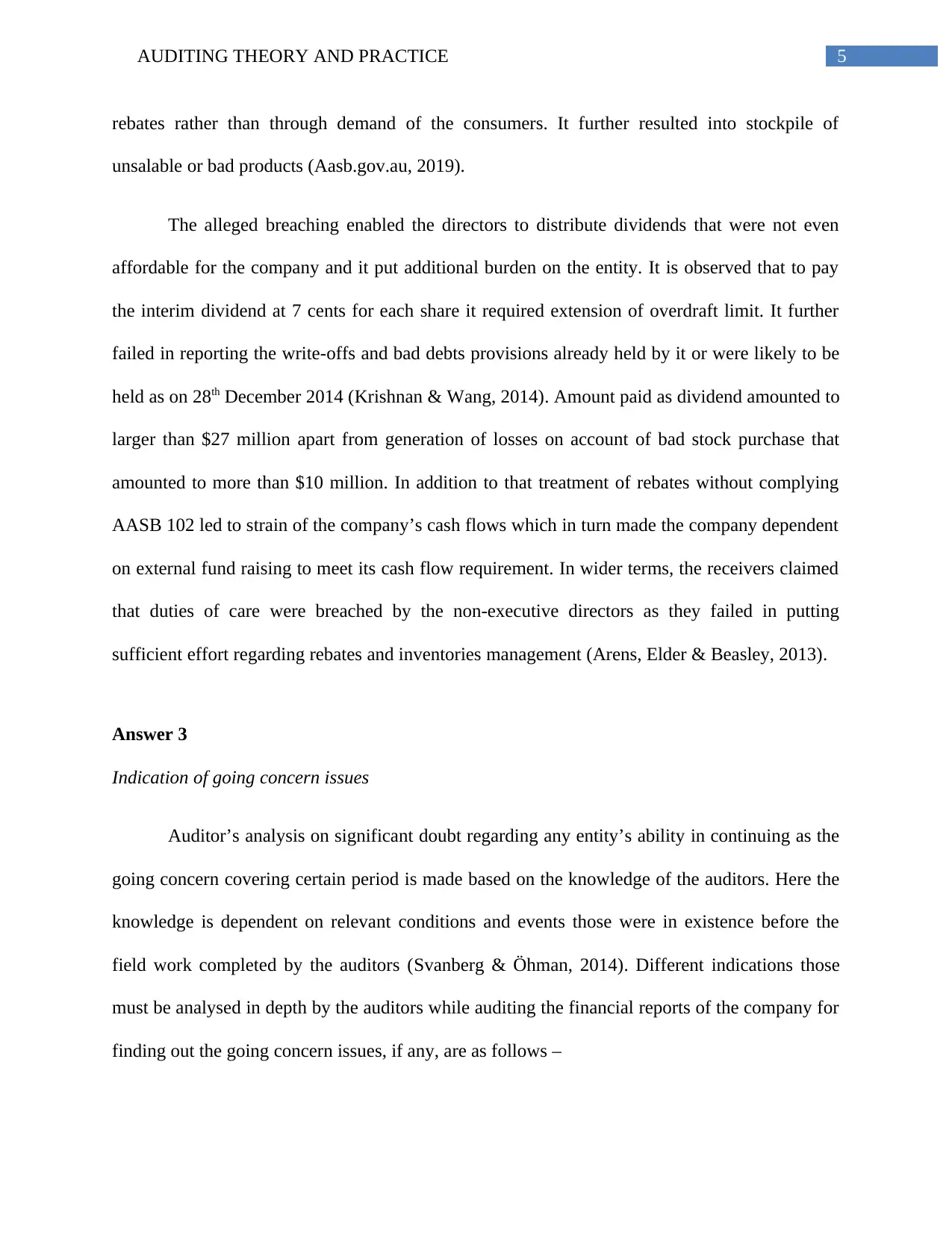
5AUDITING THEORY AND PRACTICE
rebates rather than through demand of the consumers. It further resulted into stockpile of
unsalable or bad products (Aasb.gov.au, 2019).
The alleged breaching enabled the directors to distribute dividends that were not even
affordable for the company and it put additional burden on the entity. It is observed that to pay
the interim dividend at 7 cents for each share it required extension of overdraft limit. It further
failed in reporting the write-offs and bad debts provisions already held by it or were likely to be
held as on 28th December 2014 (Krishnan & Wang, 2014). Amount paid as dividend amounted to
larger than $27 million apart from generation of losses on account of bad stock purchase that
amounted to more than $10 million. In addition to that treatment of rebates without complying
AASB 102 led to strain of the company’s cash flows which in turn made the company dependent
on external fund raising to meet its cash flow requirement. In wider terms, the receivers claimed
that duties of care were breached by the non-executive directors as they failed in putting
sufficient effort regarding rebates and inventories management (Arens, Elder & Beasley, 2013).
Answer 3
Indication of going concern issues
Auditor’s analysis on significant doubt regarding any entity’s ability in continuing as the
going concern covering certain period is made based on the knowledge of the auditors. Here the
knowledge is dependent on relevant conditions and events those were in existence before the
field work completed by the auditors (Svanberg & Öhman, 2014). Different indications those
must be analysed in depth by the auditors while auditing the financial reports of the company for
finding out the going concern issues, if any, are as follows –
rebates rather than through demand of the consumers. It further resulted into stockpile of
unsalable or bad products (Aasb.gov.au, 2019).
The alleged breaching enabled the directors to distribute dividends that were not even
affordable for the company and it put additional burden on the entity. It is observed that to pay
the interim dividend at 7 cents for each share it required extension of overdraft limit. It further
failed in reporting the write-offs and bad debts provisions already held by it or were likely to be
held as on 28th December 2014 (Krishnan & Wang, 2014). Amount paid as dividend amounted to
larger than $27 million apart from generation of losses on account of bad stock purchase that
amounted to more than $10 million. In addition to that treatment of rebates without complying
AASB 102 led to strain of the company’s cash flows which in turn made the company dependent
on external fund raising to meet its cash flow requirement. In wider terms, the receivers claimed
that duties of care were breached by the non-executive directors as they failed in putting
sufficient effort regarding rebates and inventories management (Arens, Elder & Beasley, 2013).
Answer 3
Indication of going concern issues
Auditor’s analysis on significant doubt regarding any entity’s ability in continuing as the
going concern covering certain period is made based on the knowledge of the auditors. Here the
knowledge is dependent on relevant conditions and events those were in existence before the
field work completed by the auditors (Svanberg & Öhman, 2014). Different indications those
must be analysed in depth by the auditors while auditing the financial reports of the company for
finding out the going concern issues, if any, are as follows –
⊘ This is a preview!⊘
Do you want full access?
Subscribe today to unlock all pages.

Trusted by 1+ million students worldwide
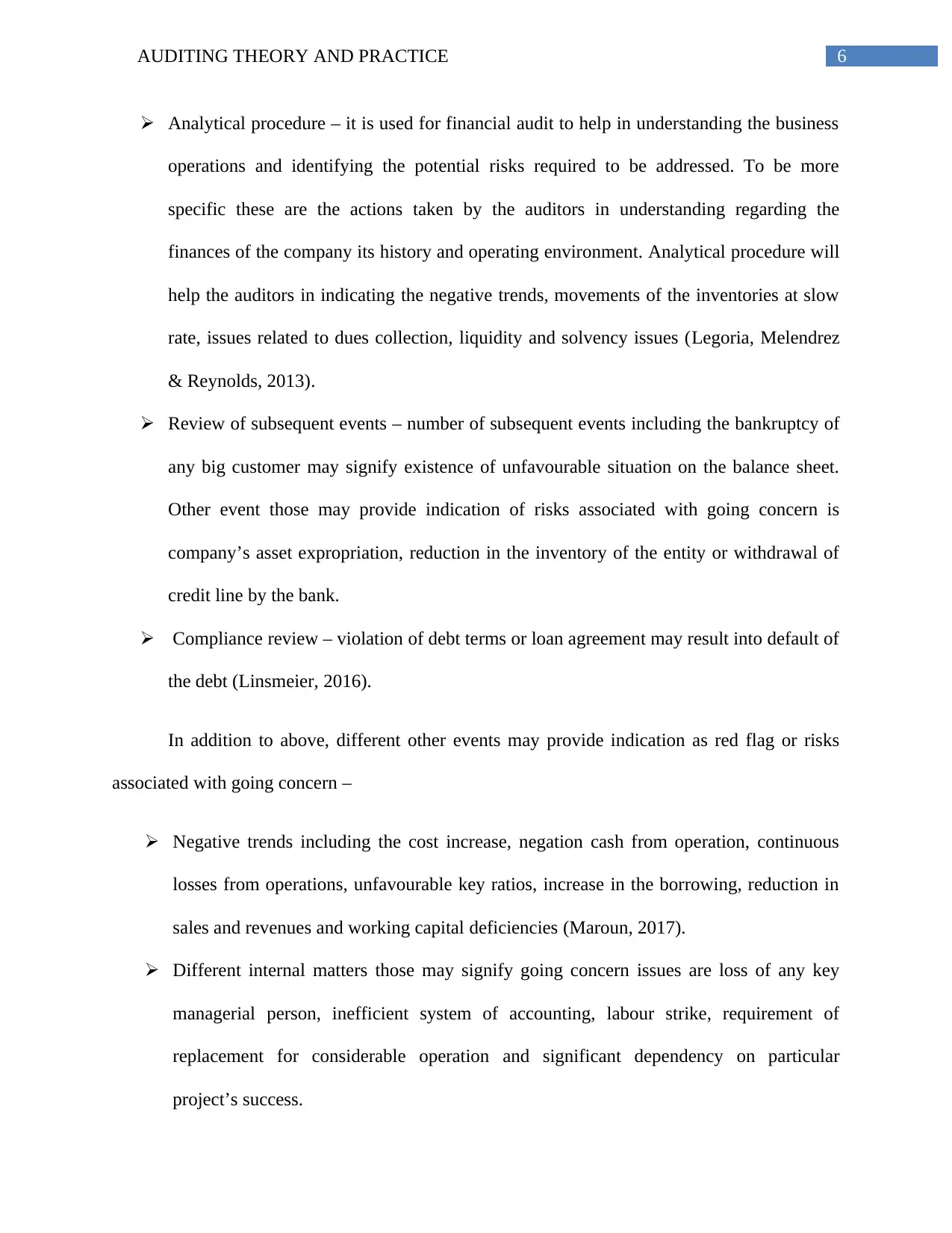
6AUDITING THEORY AND PRACTICE
Analytical procedure – it is used for financial audit to help in understanding the business
operations and identifying the potential risks required to be addressed. To be more
specific these are the actions taken by the auditors in understanding regarding the
finances of the company its history and operating environment. Analytical procedure will
help the auditors in indicating the negative trends, movements of the inventories at slow
rate, issues related to dues collection, liquidity and solvency issues (Legoria, Melendrez
& Reynolds, 2013).
Review of subsequent events – number of subsequent events including the bankruptcy of
any big customer may signify existence of unfavourable situation on the balance sheet.
Other event those may provide indication of risks associated with going concern is
company’s asset expropriation, reduction in the inventory of the entity or withdrawal of
credit line by the bank.
Compliance review – violation of debt terms or loan agreement may result into default of
the debt (Linsmeier, 2016).
In addition to above, different other events may provide indication as red flag or risks
associated with going concern –
Negative trends including the cost increase, negation cash from operation, continuous
losses from operations, unfavourable key ratios, increase in the borrowing, reduction in
sales and revenues and working capital deficiencies (Maroun, 2017).
Different internal matters those may signify going concern issues are loss of any key
managerial person, inefficient system of accounting, labour strike, requirement of
replacement for considerable operation and significant dependency on particular
project’s success.
Analytical procedure – it is used for financial audit to help in understanding the business
operations and identifying the potential risks required to be addressed. To be more
specific these are the actions taken by the auditors in understanding regarding the
finances of the company its history and operating environment. Analytical procedure will
help the auditors in indicating the negative trends, movements of the inventories at slow
rate, issues related to dues collection, liquidity and solvency issues (Legoria, Melendrez
& Reynolds, 2013).
Review of subsequent events – number of subsequent events including the bankruptcy of
any big customer may signify existence of unfavourable situation on the balance sheet.
Other event those may provide indication of risks associated with going concern is
company’s asset expropriation, reduction in the inventory of the entity or withdrawal of
credit line by the bank.
Compliance review – violation of debt terms or loan agreement may result into default of
the debt (Linsmeier, 2016).
In addition to above, different other events may provide indication as red flag or risks
associated with going concern –
Negative trends including the cost increase, negation cash from operation, continuous
losses from operations, unfavourable key ratios, increase in the borrowing, reduction in
sales and revenues and working capital deficiencies (Maroun, 2017).
Different internal matters those may signify going concern issues are loss of any key
managerial person, inefficient system of accounting, labour strike, requirement of
replacement for considerable operation and significant dependency on particular
project’s success.
Paraphrase This Document
Need a fresh take? Get an instant paraphrase of this document with our AI Paraphraser
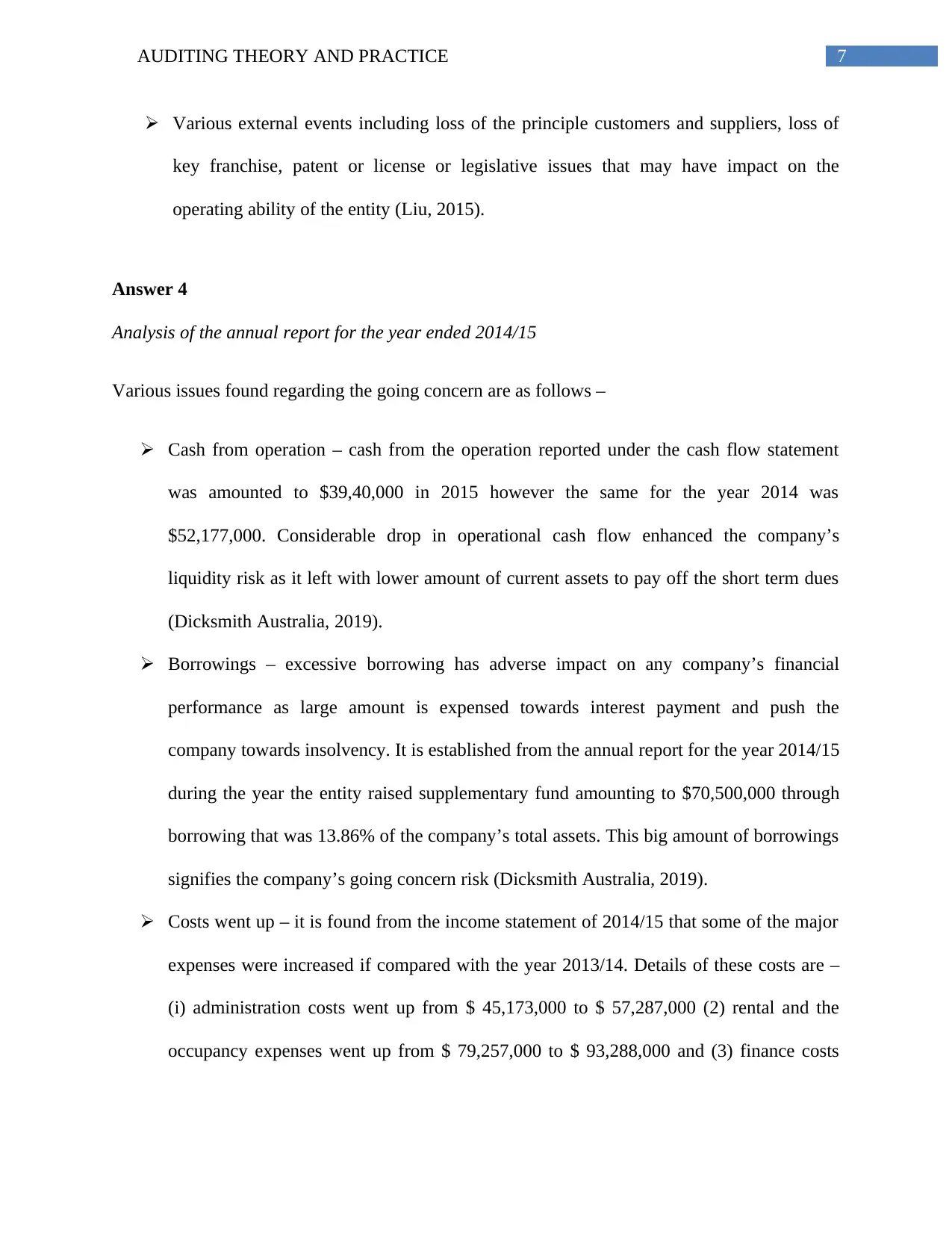
7AUDITING THEORY AND PRACTICE
Various external events including loss of the principle customers and suppliers, loss of
key franchise, patent or license or legislative issues that may have impact on the
operating ability of the entity (Liu, 2015).
Answer 4
Analysis of the annual report for the year ended 2014/15
Various issues found regarding the going concern are as follows –
Cash from operation – cash from the operation reported under the cash flow statement
was amounted to $39,40,000 in 2015 however the same for the year 2014 was
$52,177,000. Considerable drop in operational cash flow enhanced the company’s
liquidity risk as it left with lower amount of current assets to pay off the short term dues
(Dicksmith Australia, 2019).
Borrowings – excessive borrowing has adverse impact on any company’s financial
performance as large amount is expensed towards interest payment and push the
company towards insolvency. It is established from the annual report for the year 2014/15
during the year the entity raised supplementary fund amounting to $70,500,000 through
borrowing that was 13.86% of the company’s total assets. This big amount of borrowings
signifies the company’s going concern risk (Dicksmith Australia, 2019).
Costs went up – it is found from the income statement of 2014/15 that some of the major
expenses were increased if compared with the year 2013/14. Details of these costs are –
(i) administration costs went up from $ 45,173,000 to $ 57,287,000 (2) rental and the
occupancy expenses went up from $ 79,257,000 to $ 93,288,000 and (3) finance costs
Various external events including loss of the principle customers and suppliers, loss of
key franchise, patent or license or legislative issues that may have impact on the
operating ability of the entity (Liu, 2015).
Answer 4
Analysis of the annual report for the year ended 2014/15
Various issues found regarding the going concern are as follows –
Cash from operation – cash from the operation reported under the cash flow statement
was amounted to $39,40,000 in 2015 however the same for the year 2014 was
$52,177,000. Considerable drop in operational cash flow enhanced the company’s
liquidity risk as it left with lower amount of current assets to pay off the short term dues
(Dicksmith Australia, 2019).
Borrowings – excessive borrowing has adverse impact on any company’s financial
performance as large amount is expensed towards interest payment and push the
company towards insolvency. It is established from the annual report for the year 2014/15
during the year the entity raised supplementary fund amounting to $70,500,000 through
borrowing that was 13.86% of the company’s total assets. This big amount of borrowings
signifies the company’s going concern risk (Dicksmith Australia, 2019).
Costs went up – it is found from the income statement of 2014/15 that some of the major
expenses were increased if compared with the year 2013/14. Details of these costs are –
(i) administration costs went up from $ 45,173,000 to $ 57,287,000 (2) rental and the
occupancy expenses went up from $ 79,257,000 to $ 93,288,000 and (3) finance costs
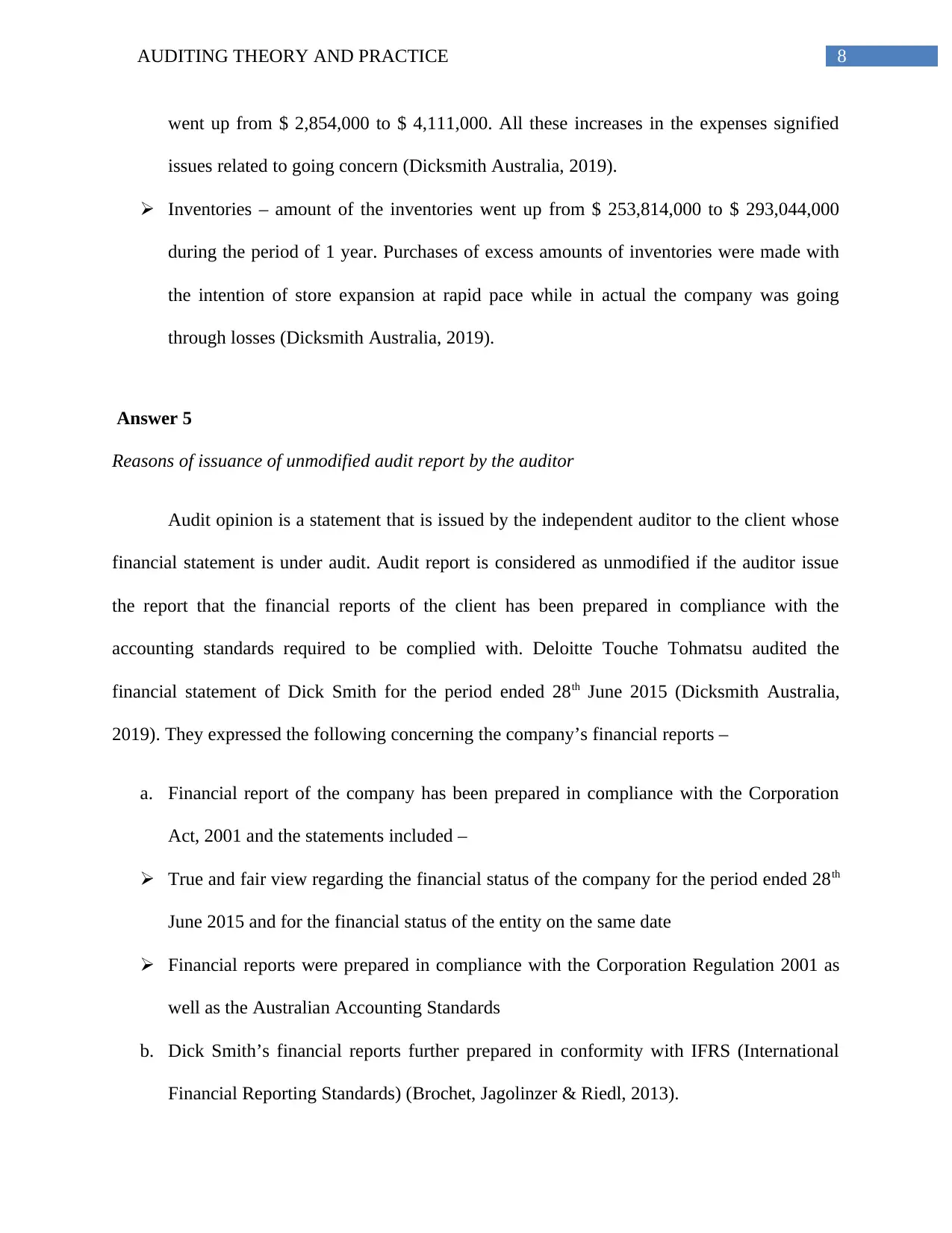
8AUDITING THEORY AND PRACTICE
went up from $ 2,854,000 to $ 4,111,000. All these increases in the expenses signified
issues related to going concern (Dicksmith Australia, 2019).
Inventories – amount of the inventories went up from $ 253,814,000 to $ 293,044,000
during the period of 1 year. Purchases of excess amounts of inventories were made with
the intention of store expansion at rapid pace while in actual the company was going
through losses (Dicksmith Australia, 2019).
Answer 5
Reasons of issuance of unmodified audit report by the auditor
Audit opinion is a statement that is issued by the independent auditor to the client whose
financial statement is under audit. Audit report is considered as unmodified if the auditor issue
the report that the financial reports of the client has been prepared in compliance with the
accounting standards required to be complied with. Deloitte Touche Tohmatsu audited the
financial statement of Dick Smith for the period ended 28th June 2015 (Dicksmith Australia,
2019). They expressed the following concerning the company’s financial reports –
a. Financial report of the company has been prepared in compliance with the Corporation
Act, 2001 and the statements included –
True and fair view regarding the financial status of the company for the period ended 28th
June 2015 and for the financial status of the entity on the same date
Financial reports were prepared in compliance with the Corporation Regulation 2001 as
well as the Australian Accounting Standards
b. Dick Smith’s financial reports further prepared in conformity with IFRS (International
Financial Reporting Standards) (Brochet, Jagolinzer & Riedl, 2013).
went up from $ 2,854,000 to $ 4,111,000. All these increases in the expenses signified
issues related to going concern (Dicksmith Australia, 2019).
Inventories – amount of the inventories went up from $ 253,814,000 to $ 293,044,000
during the period of 1 year. Purchases of excess amounts of inventories were made with
the intention of store expansion at rapid pace while in actual the company was going
through losses (Dicksmith Australia, 2019).
Answer 5
Reasons of issuance of unmodified audit report by the auditor
Audit opinion is a statement that is issued by the independent auditor to the client whose
financial statement is under audit. Audit report is considered as unmodified if the auditor issue
the report that the financial reports of the client has been prepared in compliance with the
accounting standards required to be complied with. Deloitte Touche Tohmatsu audited the
financial statement of Dick Smith for the period ended 28th June 2015 (Dicksmith Australia,
2019). They expressed the following concerning the company’s financial reports –
a. Financial report of the company has been prepared in compliance with the Corporation
Act, 2001 and the statements included –
True and fair view regarding the financial status of the company for the period ended 28th
June 2015 and for the financial status of the entity on the same date
Financial reports were prepared in compliance with the Corporation Regulation 2001 as
well as the Australian Accounting Standards
b. Dick Smith’s financial reports further prepared in conformity with IFRS (International
Financial Reporting Standards) (Brochet, Jagolinzer & Riedl, 2013).
⊘ This is a preview!⊘
Do you want full access?
Subscribe today to unlock all pages.

Trusted by 1+ million students worldwide
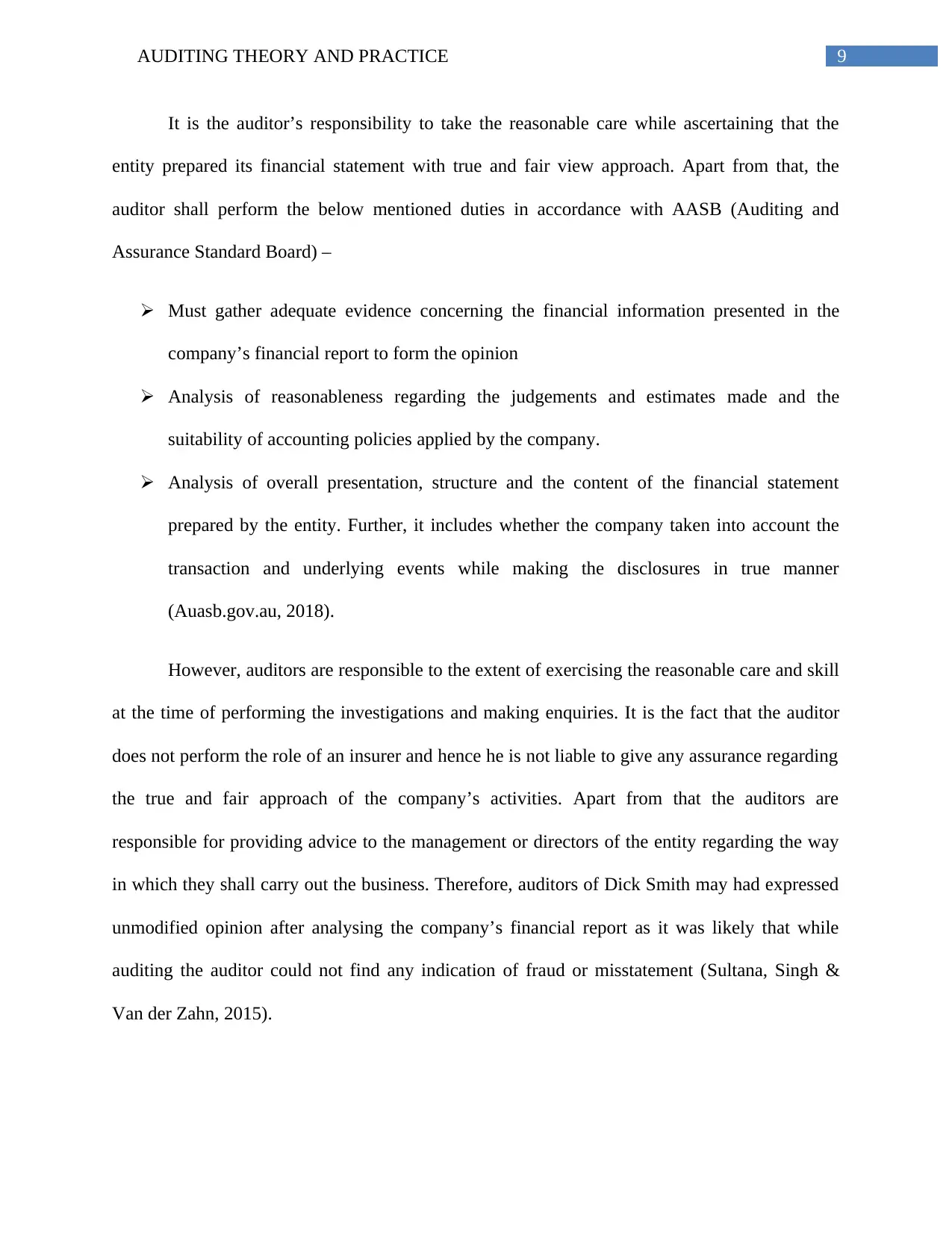
9AUDITING THEORY AND PRACTICE
It is the auditor’s responsibility to take the reasonable care while ascertaining that the
entity prepared its financial statement with true and fair view approach. Apart from that, the
auditor shall perform the below mentioned duties in accordance with AASB (Auditing and
Assurance Standard Board) –
Must gather adequate evidence concerning the financial information presented in the
company’s financial report to form the opinion
Analysis of reasonableness regarding the judgements and estimates made and the
suitability of accounting policies applied by the company.
Analysis of overall presentation, structure and the content of the financial statement
prepared by the entity. Further, it includes whether the company taken into account the
transaction and underlying events while making the disclosures in true manner
(Auasb.gov.au, 2018).
However, auditors are responsible to the extent of exercising the reasonable care and skill
at the time of performing the investigations and making enquiries. It is the fact that the auditor
does not perform the role of an insurer and hence he is not liable to give any assurance regarding
the true and fair approach of the company’s activities. Apart from that the auditors are
responsible for providing advice to the management or directors of the entity regarding the way
in which they shall carry out the business. Therefore, auditors of Dick Smith may had expressed
unmodified opinion after analysing the company’s financial report as it was likely that while
auditing the auditor could not find any indication of fraud or misstatement (Sultana, Singh &
Van der Zahn, 2015).
It is the auditor’s responsibility to take the reasonable care while ascertaining that the
entity prepared its financial statement with true and fair view approach. Apart from that, the
auditor shall perform the below mentioned duties in accordance with AASB (Auditing and
Assurance Standard Board) –
Must gather adequate evidence concerning the financial information presented in the
company’s financial report to form the opinion
Analysis of reasonableness regarding the judgements and estimates made and the
suitability of accounting policies applied by the company.
Analysis of overall presentation, structure and the content of the financial statement
prepared by the entity. Further, it includes whether the company taken into account the
transaction and underlying events while making the disclosures in true manner
(Auasb.gov.au, 2018).
However, auditors are responsible to the extent of exercising the reasonable care and skill
at the time of performing the investigations and making enquiries. It is the fact that the auditor
does not perform the role of an insurer and hence he is not liable to give any assurance regarding
the true and fair approach of the company’s activities. Apart from that the auditors are
responsible for providing advice to the management or directors of the entity regarding the way
in which they shall carry out the business. Therefore, auditors of Dick Smith may had expressed
unmodified opinion after analysing the company’s financial report as it was likely that while
auditing the auditor could not find any indication of fraud or misstatement (Sultana, Singh &
Van der Zahn, 2015).
Paraphrase This Document
Need a fresh take? Get an instant paraphrase of this document with our AI Paraphraser
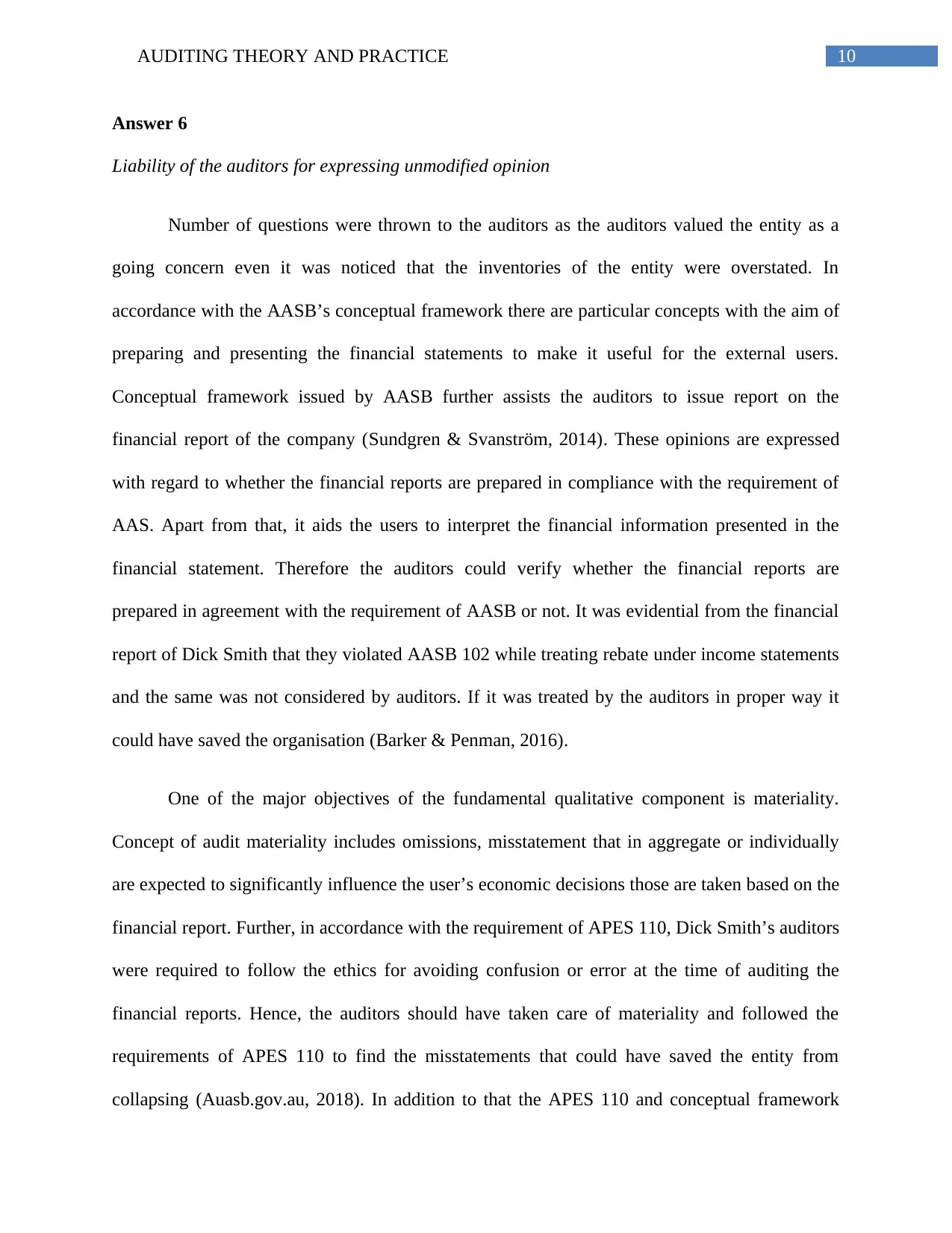
10AUDITING THEORY AND PRACTICE
Answer 6
Liability of the auditors for expressing unmodified opinion
Number of questions were thrown to the auditors as the auditors valued the entity as a
going concern even it was noticed that the inventories of the entity were overstated. In
accordance with the AASB’s conceptual framework there are particular concepts with the aim of
preparing and presenting the financial statements to make it useful for the external users.
Conceptual framework issued by AASB further assists the auditors to issue report on the
financial report of the company (Sundgren & Svanström, 2014). These opinions are expressed
with regard to whether the financial reports are prepared in compliance with the requirement of
AAS. Apart from that, it aids the users to interpret the financial information presented in the
financial statement. Therefore the auditors could verify whether the financial reports are
prepared in agreement with the requirement of AASB or not. It was evidential from the financial
report of Dick Smith that they violated AASB 102 while treating rebate under income statements
and the same was not considered by auditors. If it was treated by the auditors in proper way it
could have saved the organisation (Barker & Penman, 2016).
One of the major objectives of the fundamental qualitative component is materiality.
Concept of audit materiality includes omissions, misstatement that in aggregate or individually
are expected to significantly influence the user’s economic decisions those are taken based on the
financial report. Further, in accordance with the requirement of APES 110, Dick Smith’s auditors
were required to follow the ethics for avoiding confusion or error at the time of auditing the
financial reports. Hence, the auditors should have taken care of materiality and followed the
requirements of APES 110 to find the misstatements that could have saved the entity from
collapsing (Auasb.gov.au, 2018). In addition to that the APES 110 and conceptual framework
Answer 6
Liability of the auditors for expressing unmodified opinion
Number of questions were thrown to the auditors as the auditors valued the entity as a
going concern even it was noticed that the inventories of the entity were overstated. In
accordance with the AASB’s conceptual framework there are particular concepts with the aim of
preparing and presenting the financial statements to make it useful for the external users.
Conceptual framework issued by AASB further assists the auditors to issue report on the
financial report of the company (Sundgren & Svanström, 2014). These opinions are expressed
with regard to whether the financial reports are prepared in compliance with the requirement of
AAS. Apart from that, it aids the users to interpret the financial information presented in the
financial statement. Therefore the auditors could verify whether the financial reports are
prepared in agreement with the requirement of AASB or not. It was evidential from the financial
report of Dick Smith that they violated AASB 102 while treating rebate under income statements
and the same was not considered by auditors. If it was treated by the auditors in proper way it
could have saved the organisation (Barker & Penman, 2016).
One of the major objectives of the fundamental qualitative component is materiality.
Concept of audit materiality includes omissions, misstatement that in aggregate or individually
are expected to significantly influence the user’s economic decisions those are taken based on the
financial report. Further, in accordance with the requirement of APES 110, Dick Smith’s auditors
were required to follow the ethics for avoiding confusion or error at the time of auditing the
financial reports. Hence, the auditors should have taken care of materiality and followed the
requirements of APES 110 to find the misstatements that could have saved the entity from
collapsing (Auasb.gov.au, 2018). In addition to that the APES 110 and conceptual framework
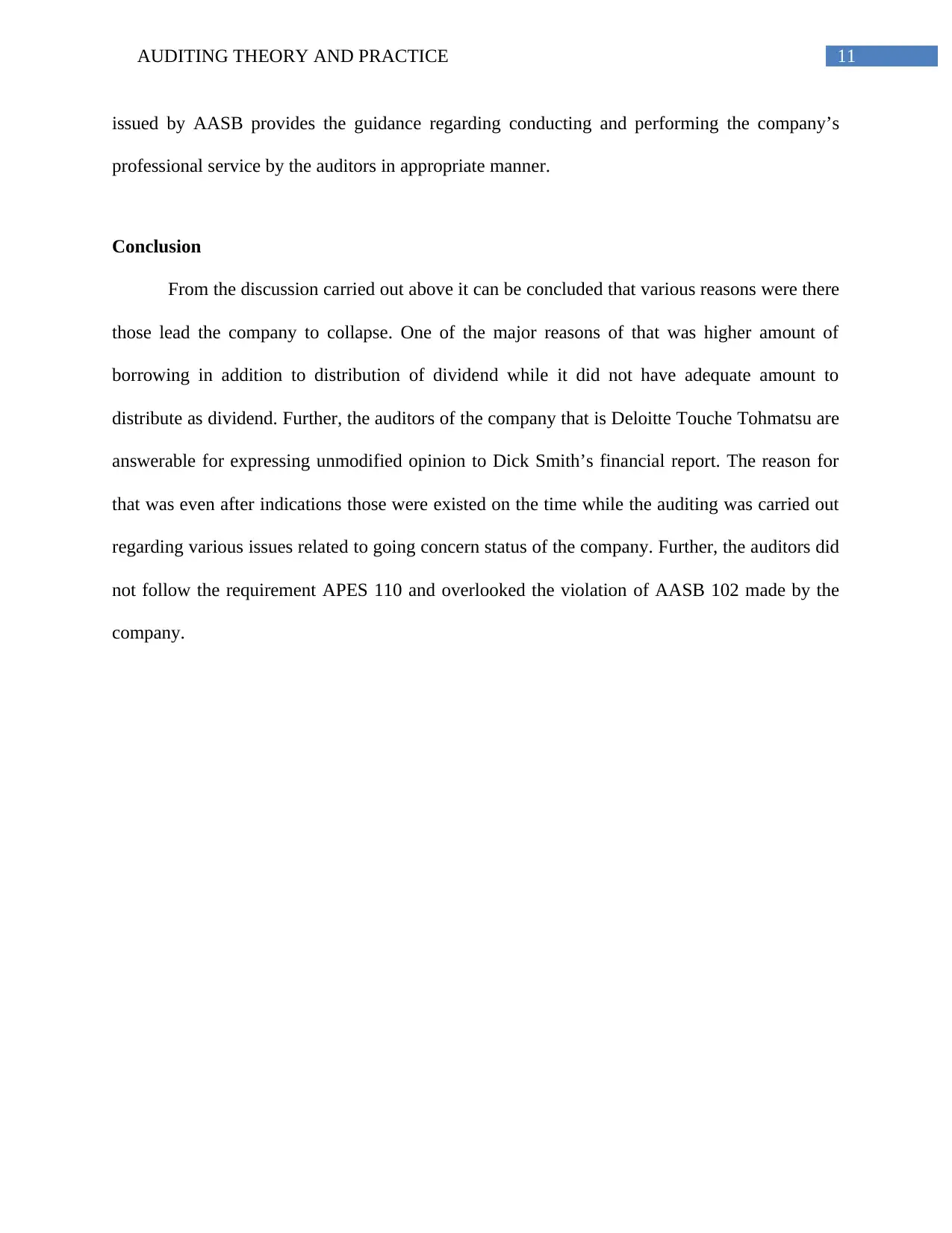
11AUDITING THEORY AND PRACTICE
issued by AASB provides the guidance regarding conducting and performing the company’s
professional service by the auditors in appropriate manner.
Conclusion
From the discussion carried out above it can be concluded that various reasons were there
those lead the company to collapse. One of the major reasons of that was higher amount of
borrowing in addition to distribution of dividend while it did not have adequate amount to
distribute as dividend. Further, the auditors of the company that is Deloitte Touche Tohmatsu are
answerable for expressing unmodified opinion to Dick Smith’s financial report. The reason for
that was even after indications those were existed on the time while the auditing was carried out
regarding various issues related to going concern status of the company. Further, the auditors did
not follow the requirement APES 110 and overlooked the violation of AASB 102 made by the
company.
issued by AASB provides the guidance regarding conducting and performing the company’s
professional service by the auditors in appropriate manner.
Conclusion
From the discussion carried out above it can be concluded that various reasons were there
those lead the company to collapse. One of the major reasons of that was higher amount of
borrowing in addition to distribution of dividend while it did not have adequate amount to
distribute as dividend. Further, the auditors of the company that is Deloitte Touche Tohmatsu are
answerable for expressing unmodified opinion to Dick Smith’s financial report. The reason for
that was even after indications those were existed on the time while the auditing was carried out
regarding various issues related to going concern status of the company. Further, the auditors did
not follow the requirement APES 110 and overlooked the violation of AASB 102 made by the
company.
⊘ This is a preview!⊘
Do you want full access?
Subscribe today to unlock all pages.

Trusted by 1+ million students worldwide
1 out of 15
Related Documents
Your All-in-One AI-Powered Toolkit for Academic Success.
+13062052269
info@desklib.com
Available 24*7 on WhatsApp / Email
![[object Object]](/_next/static/media/star-bottom.7253800d.svg)
Unlock your academic potential
Copyright © 2020–2025 A2Z Services. All Rights Reserved. Developed and managed by ZUCOL.





